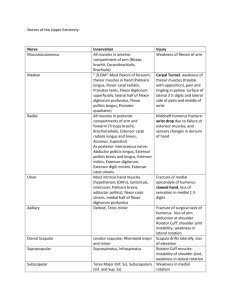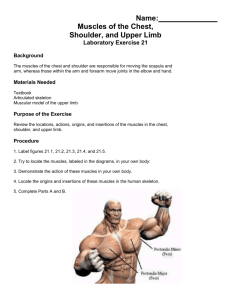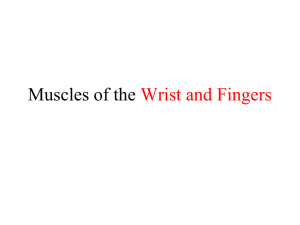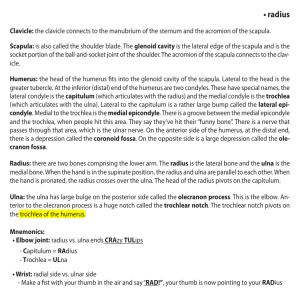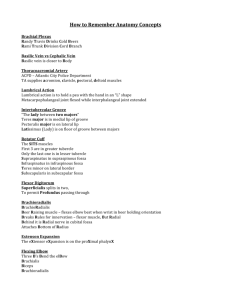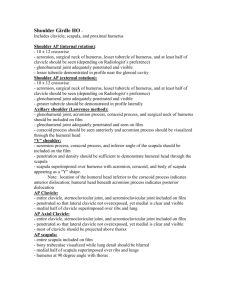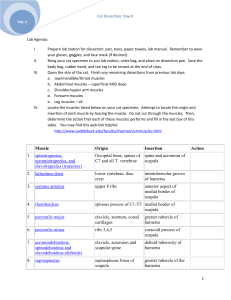Muscles of the Upper Extremity
advertisement
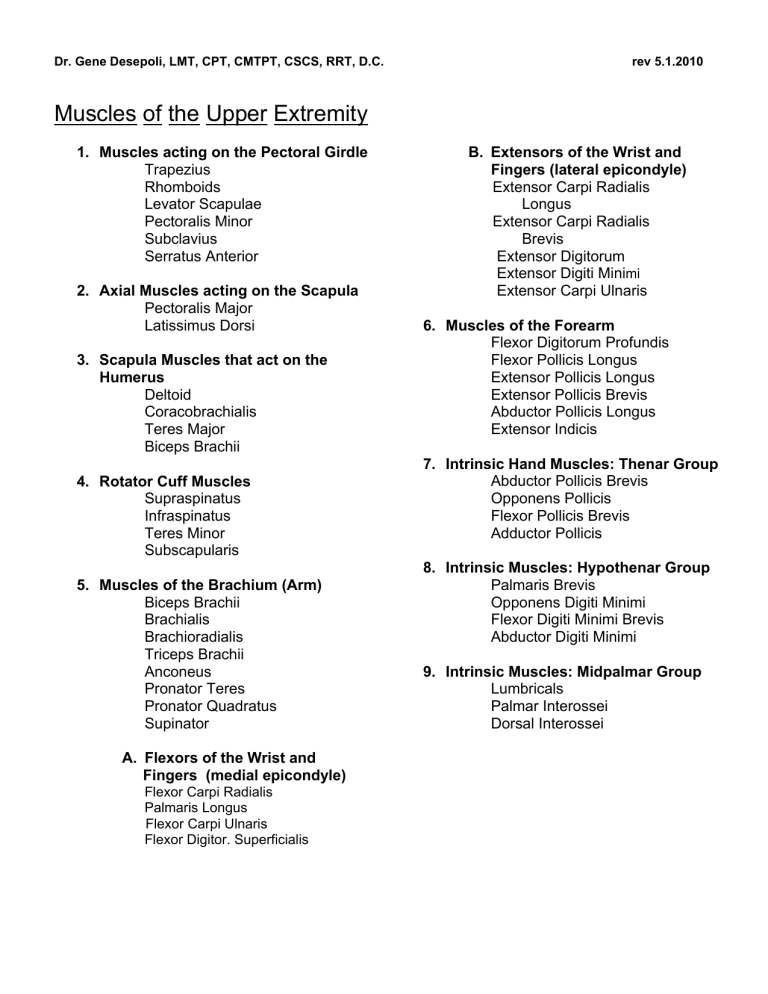
Dr. Gene Desepoli, LMT, CPT, CMTPT, CSCS, RRT, D.C. rev 5.1.2010 Muscles of the Upper Extremity 1. Muscles acting on the Pectoral Girdle Trapezius Rhomboids Levator Scapulae Pectoralis Minor Subclavius Serratus Anterior 2. Axial Muscles acting on the Scapula Pectoralis Major Latissimus Dorsi 3. Scapula Muscles that act on the Humerus Deltoid Coracobrachialis Teres Major Biceps Brachii 4. Rotator Cuff Muscles Supraspinatus Infraspinatus Teres Minor Subscapularis 5. Muscles of the Brachium (Arm) Biceps Brachii Brachialis Brachioradialis Triceps Brachii Anconeus Pronator Teres Pronator Quadratus Supinator A. Flexors of the Wrist and Fingers (medial epicondyle) Flexor Carpi Radialis Palmaris Longus Flexor Carpi Ulnaris Flexor Digitor. Superficialis B. Extensors of the Wrist and Fingers (lateral epicondyle) Extensor Carpi Radialis Longus Extensor Carpi Radialis Brevis Extensor Digitorum Extensor Digiti Minimi Extensor Carpi Ulnaris 6. Muscles of the Forearm Flexor Digitorum Profundis Flexor Pollicis Longus Extensor Pollicis Longus Extensor Pollicis Brevis Abductor Pollicis Longus Extensor Indicis 7. Intrinsic Hand Muscles: Thenar Group Abductor Pollicis Brevis Opponens Pollicis Flexor Pollicis Brevis Adductor Pollicis 8. Intrinsic Muscles: Hypothenar Group Palmaris Brevis Opponens Digiti Minimi Flexor Digiti Minimi Brevis Abductor Digiti Minimi 9. Intrinsic Muscles: Midpalmar Group Lumbricals Palmar Interossei Dorsal Interossei Upper Extremity: Muscles Acting on the Pectoral Girdle Muscle Origin Insertion Nerve Actions Upper fibers: Elevates and upwardly rotates scapula Rotates head to opposite side Extends and laterally flexes head/neck to same side Trapezius EOP, Ligamentum nuchae, SPs of C7-T12 Clavicle (lateral 1/3), Acromion Spine of scapula Spinal Accessory (XI) & C3-C4 Middle fibers: Retracts scapula Lower fibers: Depresses scapula and upwardly rotates scapula Bilaterally: assists extension of cervical spine (head/neck ) & thoracic spine Rhomboid Minor Rhomboid Major SPs of C7-T1 TPs of C1-C4 Pectoralis Minor Ribs 3-5 Serratus Anterior Dorsal Scapular (C4-C5) Superior Angle of the Scapula Dorsal Scapular (C3-C5) Coracoid Process of Scapula (medial part) Medial Pecctoral (C8-T1) Under surface of Clavicle Nerve to Subclavius (C5-C6) Anterior surface of medial border of Scapula Long Thoracic (C5-C7) Weakness = Flaring of the scapula; Coexists with tight pec. minor SPs of T2-T5 Levator Scapulae Subclavius Medial border of Scapula at root of and below the spine ● Retracts (adducts) scapula ● Downward rotation of scapula (elevates medial border) 1st Rib (at costocartialge junction) Upper 8 or 9 Ribs Stiff Neck muscle ● Elevates scapula & downward rotation ● Ipsilateral rotation of neck (same side) ● Laterally bends neck (reverse action) ● Bilaterally extends head/neck ● Protracts scapula ● pulls scapula downward (depresses) ● Raises ribs in forced inspiration Pec minor syndrome the “backpack” muscle ● draws clavicle downward ● stabilizes clavicle with shoulder girdle movements ● Protracts and depresses scapula ● Assists in upward rotation of scapula for arm abduction ● Assists with inspiration weakness = winging These structures attach to the coracoid process: 1. pectoralis minor 2. biceps brachii (short head) 3. coracobrachialis Note: humerus = shoulder = arm elbow = forearm wrist = hand ipsilateral - same side contralateral = opposite Upper Extremity: Axial Muscles acting on the Humerus Muscle Pectoralis Major Origin Clavicle (medial 1/2), Sternum, upper 6 ribs Insertion Intertubercular (bicipal) groove – lateral lip Nerve Clav: Lateral Pectoral (C5-C7) Scap: Medial Pectoral (C8-T1) Latissimus Dorsi SP’s T7-sacrum, Lower 3-4 ribs, T-L fascia & Iliac crest. Inferior angle of scapula Intertubercular (bicipal) groove – floor Thoracodorsal (C6-C8) Actions Adducts humerus Medially rotates humerus Horizontally adducts humerus Flexion of the extended arm (clavic. portion) ● Lower fibers: extend the humerus! ● ● ● ● ● ● ● ● Adducts humerus Medially rotates humerus Extends a flexed arm Downward rotation of scapula (shoulder depression) has similar actions to Teres Major handcuff or swimmer’s muscle Upper Extremity: Scapula muscles acting on the Humerus Muscle Deltoid Coracobrachialis Teres Major Biceps Brachii Origin Insertion Nerve Deltoid Tuberosity of Humerus Axillary (C5-C6) Coracoid Process of Scapula Middle Humerus Musculocutaneous (C6-C7) ● weak flexion of the humerus ● weak adduction of humerus Lateral border of Scapula (lower 1/3rd) Intertubercular (bicipal) groove – medial lip) Lower Subscapular (C5-C6) ● Medial rotation of humerus ● Adduction of the humerus ● Extension of a flexed humerus Radias: bicipital tuberosity & Bicipital Aponeurosis (Ulna) Musculocutaneous (C5-C6) Clavicle (lateral 1/3) Spine of scapula Acromion SH: Coracoid process LH: Supraglenoid tubercle of Scapula Actions Ant. fibers: Flexion Medial rotation Horizontal Adduction Mid. fibers: Abducts Humerus Post fibers: Extension Lateral rotation, Horizontal abduction deep to short head of biceps mini-Latissimus (same actions) ● Weak shoulder flexion (7%) ● Forearm flexion and supination - crosses 2 joints Note: “the lady walking between 2 majors” This might help you remember the insertions of the Pectoralis Major and Teres Major surrounding the Latissimus Dorsi insertion at the bicipital groove area of the humerus. Also, these muscles have very similar actions (all adduct and internally rotate the humerus) Upper Extremity: Rotator Cuff Muscles “SITS” Muscle Supraspinatus Infraspinatus Teres Minor Subscapularis Origin Supraspinous Fossa of scapula Infraspinatus Fossa of scapula Lateral border of scapula (upper 2/3rd) Subscapular Fossa (anterior scapula) Insertion Nerve Actions ● Initiates abduction of the humerus Greater Tubercle Of Humerus the “suitcase muscle” Suprascapular (C5-C6) ● Lateral rotation of humerus ● Depresses humerus during abduction to prevent impingement (force couple) Axillary (C5) Lesser Tubercle Of Humerus Upper & Lower Subscapular (C5-C6) ● Medial Rotation of humerus ● Adduction of humerus ● Stabilizes humerus during abduction pseudo-Frozen shoulder A pro baseball pitcher injures his rotator cuff muscles. As a result, he SITS out for the rest of the game and then gets sent down to the MINOR leagues. Upper Extremity: Muscles of the Brachium (Arm) Muscle Biceps Brachii Brachialis Brachioradialis Triceps Brachii Origin SH: Coracoid process LH: Supraglenoid tubercle of Scapula Humerus (anterior lower ½ ) Humerus (just above lateral epicondyle) LH: Infraglenoid tubercle of Scapula Lat: Upr. ½ of post humerus Med: Lower ½ of post. Humerus Anconeus Lateral Epicondyle of Humerus Pronator Teres Humeral head: medial epicondyle & CFT Ulnar head: Coranoid process Pronator Quadratus Distal ¼ of anterior Ulna Supinator Humerus: Lateral epicondyle Annular ligament Crest of Ulna Insertion Radias: bicipital tuberosity & Bicipital Aponeurosis (Ulna) Ulna (coranoid process) Radius (styloid process) Nerve Musculocutaneous (C5-C6) Musculocutaneous Actions ● Shoulder / humerus flexion (7%) ● Forearm flesion and supination crosses 2 joints (C5-C6) ● Flexion of the elbow (forearm) deep to Biceps brachii Radial ● Flexes the forearm (elbow) ● Supinates the forearm when pronated ● Pronates the forearm when supinated (C5-C6) “so-so” Olecranon Process of Ulna Radial (C6-C7) Radial (C7-C8) middle Radius (lateral side) Middle anterior ● Extension of elbow (forearm) ● aids extension of arm / humerus ● aids adduction of arm / humerus crosses 2 joints tendon of long head passes betw. 2 teres muscles ● Extends the elbow (assists Triceps) ● Supports the elbow in full extension ● Pronates forearm (elbow) during rapid or forced pronation involved in Pronator Teres Syndrome ( median nerve entrapment) Median (C8-T1) ● Assists forearm flexion Median Radius (C8-T1) Radius Radial lateral proximal surface the “handshake” muscle the beer drinkers muscle attaches distal to distal (C6) ● Pronates the forearm the deepest forearm muscle ● Supinates the forearm (at superior radioulnar joint) The 3 “B’s” and Pronator Teres bend (flex) the forearm and all have the root “brachi” in their name. Note: forearm = elbow arm = humerus Upper Extremity: Flexors of the Wrist and Fingers Muscle Flexor Carpi Radialis All originate from the Medial Epicondyle of the Humerus Origin Insertion Nerve CFT @ Medial Epicondyle 2nd & 3rd metacarpals Actions ● Wrist (and elbow) flexion ● Wrist abduction (radial deviation) Median (C6-C7) Palmaris Longus CFT @ Medial Epicondyle Flexor retinaculum & Palmar Aponeurosis CFT @ Medial Epicondyle & Proximal Ulna Pisiform, Hamate & 5th metacarpal Flexor Carpi Ulnaris Flexor Digitorum Superficialis Medial Epicondyle (CFT), Ulna - coranoid process 4 medial fingers ● Assists wrist (and elbow) flexion ● Tenses fascia of palm for gripping - associated with Palmar Fasciitis - sometimes used for tendon repair Ulnar (C8-T1) ● Wrist (and elbow) flexion ● Wrist adduction (ulnar deviation) May entrap the Ulnar nerve ! Median (C7-T1) Radius (ant shaft) ● Flexes middle phalanges of 4 fingers @ PIP joint (4 tendons divine into 2 slips each); Wrist flexion Muscles on the anterior forearm: PASS/FAIL/PASS/FAIL Pronator Teres, Flex. Carpi Radialis, Palmaris Longus, Flex. Carpi Ulnaris Upper Extremity: Extensors of the Wrist and Fingers Muscle Extensor Carpi Radialis Longus Origin Insertion Humerus 2nd metacarpal (lateral supra-condylar ridge) All originate from the Lateral Epicondyle of the Humerus Nerve (base) Radial Actions ● Extends the wrist ● Abducts (radially deviates) wrist ● Weak flexion of elbow (C6-C7) Extensor Carpi Radialis Brevis Extensor Digitorum Extensor Digiti Minimi Extensor Carpi Ulnaris 3nd metacarpal Lateral Epicondyle of Humerus via common extensor tendon (CET) Lateral Epicondyle via the CET & Upper aspect of Ext. Digitorum 1st head: Lateral Epicondyle via the CET nd 2 head: Ulnar aspect of Ext. Digitorum ● Wrist extension ● Radial deviation of wrist (base) Tennis Elbow 4 fingers (middle & distal phalanx) Little finger Radial (C6-C8) ● Extends the little finger (middle & distal phalanx) 5th metacarpal ● Extends the 4 fingers ● Extends the wrist (if fingers flexed) ● Assists wrist flexion Radial (C7-C8) ● Extends the wrist ● Ulnar deviation (adduction) of wrist remember “carpi” means wrist Upper Extremity: Muscles of the Forearm Muscle Origin Insertion Nerve Flexor Digitorum Profundus upper ¾ of Ulna, IO membrane Medial 4 fingers (distal phalanx) Ulnar & Median Flexor Pollicis Longus Middle anterior Radius, IO membrane; Ulna’s coranoid process posterior (mid 1/3) Ulna & IO membrane Extensor Pollicis Longus Extensor Pollicis posterior Radius & IO membrane Brevis Abductor Pollicis Posterior Radius, Ulna & IO membrane Longus Extensor Indicis Posterior Ulna & IO membrane (C8-T1) Actions ● Flexes distal IP joints of 4 fingers ● Flexes proximal & middle IP joints ● Flexes wrist if fingers extended -- deep to flexor digitorum superficialis Thumb (distal phalanx) Median (C-T1) Thumb (distal phalanx) Thumb (proximal phalanx) ● Extension of thumb (IP joint) Radial (C6-C7) Base of 1st metacarpal (thumb) Index (2nd) finger ● Flexes IP joint of thumb ● Flexes MCP and CMC of wrist ● Extension of thumb (at MP joint) ● Wrist abduction (radial deviation) ● Abduction and extends 1st CMC joint ● Wrist abduction (radial deviation) Radial (C6-C8) ● Extension of index finger (at MP joint) The anatomical snuffbox consists of the tendons of 3 muscles: EPL EPB APL Upper Extremity: Intrinsic Hand Muscles (Thenar Group) “OAF” Muscle Abductor Pollicis Brevis Opponens Pollicis Flexor Pollicis Brevis Adductor Pollicis Origin Tubercles of trapezium & scaphoid; Flexor retinaculum Tubercle of Trapezium Flexor retinaculum Trapezium; Flexor retinaculum rd Trans: 3 metacarpal Obliq: Base of 2nd + 3rd Metacarpal; Trapezoid; Capitate Insertion Nerve Thumb (lateral aspect) Medial ● Abducts thumb (at MCP joint) ● Assists thumb flexion (MCP joint) (C8-T1) Thumb ● Rotates the thumb into opposition (lateral aspect) Thumb ( base of prox. Phalanx) Thumb (medial aspect of base of prox. Phalanx) Medial & Ulnar (C8-T1) Ulnar (C8-T1) ● Flexes thumb (at MCP joint) ● Adducts Thumb ● Assists thumb flexion (MCP joint) Upper Extremity: Intrinsic Hand Muscles (Hypothenar Group) Muscle Origin Insertion Palmaris Brevis Palmar Aponeurosis & Flexor Retinaculum Skin of palm’s ulnar border; Pisiform Abductor Digiti Minimi Flexor Digiti Minimi Opponens Digiti Minimi Actions Pisiform & tendon of Flexor Carpi Ulnaris (medial base of proximal Phalanx) Flexor Retinaculum & Hook of the Hamate Base of prox. Phalanx of 5th finger Flexor Retinaculum & Hook of the Hamate Proximal phalanx of 5th finger 5th finger Nerve “OAF” Actions ● Aids in grip (tenses the palmar skin Ulnar (C8-T1) ● Abducts the little finger ● Flexes the 5th finger (at the MCP joint) ● Opposition of the 5th finger (at the CM joint) Upper Extremity: Intrinsic Hand Muscles (Midpalmar Group) Muscle Lumbricals Palmar Interossei Dorsal Interossei Tendons of Flex. Dig. Profundis: #1&2 have a single head of origin (radial side of tendon), #3&4 have two heads of origin (from adjacent tendon) Origin Insertion Nerve Extensor hood of fingers 2-5 Median & Ulnar (C6-C8) From the side of the metacarpal that faces the midline (to abduct them) Base of proximal phalanx of the digit of origin (same side toward midline) Between each metacarpal Directly distal to the origin on the base of the proximal phalanx closest to the midline (to abduct them) Actions ● Extends the fingers at the IP joints ● weakly flexes the fingers (at MCP joints) (assists Extensor Digitorum in finger extension w/o hyperextension at MCP joints) Ulnar (C8-T1) ● Adducts the fingers (hint: PAD ● Flexes the fingers at the MCP while the IP joints are extended ● Abducts the fingers (hint: DAB) ● Flexes the fingers at the MCP while the IP joints are extended “Pad Dab” = actions of the palmar and dorsal interossei [palmar adduct; dorsal abduct] Useful Web Sites: http://www.ptcentral.com/muscles/ Abbreviations Used: LH Long head IT intertubercular EOP extermal occipital protuberance SPs spinous processes MP metacarpophalangeal DIP = distal interphalangeal joint CM = carpometacarpal L1-L5 Lumbar vertebrae 1 through 5 SH short head I-T iliotibial IO interosseous TPs transverse processes IP interphalangeal PIP proximal interphalangeal joint T-L fascia = thoracolumbar fascia C1-C4 cervical vertebrae 1 through 4 Notes: Medial rotation = internal rotation Lateral rotation = external rotation Carpi = wrist pollicis = thumb Digitorum = 4 digits/fingers/toes CMC = carpometacarpal joint CFT = common flexor tendon CET = common extensor tendon Revised 8/11/07 for the NY Massage Therapy State Board Review Course Dr. Gene Desepoli drgenelmt@gmial.com www.medical-massage.org
